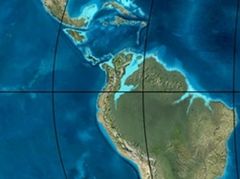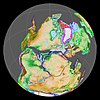Geological formation in the Colombian Andes
The Barzalosa Formation (Spanish : Formación Barzalosa , Pgb, Pgba) is a fossiliferous geological formation of the Upper Magdalena Valley and the bounding foothills of the Central Ranges and Eastern Ranges of the Colombian Andes . The formation consists of conglomerates , sandstones and siltstones . The Barzalosa Formation probably dates to the Late Paleogene to Early Neogene period; Oligocene to Early Miocene epochs, and has an approximate thickness of 360 metres (1,180 ft). Fossils of Balanerodus logimus Lophiodolodus chaparralensis Xenastrapotherium chaparralensis Protheosodon sp. Proadinotherium sp. Chaparral , Tolima .
Etymology
The formation was defined by Scheibe in 1934 and named after Barzalosa, a vereda of Girardot , Cundinamarca . Cáceres and Etayo elevated the "Pisos de Barzalosa" to a formation in 1969.[ 1]
Description
Lithologies
The Barzalosa Formation consists of conglomerates , sandstones and siltstones .[ 2] shale beds and gypsum .[ 3]
Stratigraphy and depositional environment
The approximately 360 metres (1,180 ft) thick Barzalosa Formation overlies the Olini Group and the Seca Formation in the west and is overlain by the Honda Group .[ 2] Fusagasugá , the formation overlies the La Tabla Formation and is overlain by the Carmen de Apicalá Conglomerate .[ 4] foraminifera , the age is difficult to establish, but has been estimated to be Oligocene to Early Miocene ,[ 2] Middle Eocene to Oligocene.[ 5] alluvial fans and braided rivers .[ 6]
Fossil content
Outcrops
Type locality of the Barzalosa Formation to the southwest of the Bogotá savanna
The Barzalosa Formation is apart from its type locality found in Tocaima and to the east of Agua de Dios ,[ 1] Magdalena River around Chaparral , Tolima.[ 12]
Regional correlations
Stratigraphy of the Llanos Basin and surrounding provinces
Ma Age
Paleomap
Regional events Catatumbo Cordillera proximal Llanos
distal Llanos
Putumayo VSM Environments Maximum thickness Petroleum geology Notes
0.01 Holocene Holocene volcanismSeismic activity
alluvium
Overburden
1 Pleistocene Pleistocene volcanismAndean orogeny 3Glaciations
Guayabo Soatá Sabana Necesidad Guayabo Gigante Alluvial to fluvial (Guayabo)550 m (1,800 ft) [ 13] [ 14] [ 15] [ 16]
2.6 Pliocene Pliocene volcanism Andean orogeny 3GABI Subachoque
5.3 Messinian Andean orogeny 3Foreland Marichuela Caimán Honda [ 15] [ 17]
13.5 Langhian Regional flooding
León hiatus Caja León Lacustrine (León)400 m (1,300 ft) Seal [ 16] [ 18]
16.2 Burdigalian Miocene inundationsAndean orogeny 2
C1 Carbonera C1 Ospina Proximal fluvio-deltaic (C1)
850 m (2,790 ft) Reservoir [ 17] [ 16]
17.3 C2 Carbonera C2 Distal lacustrine-deltaic (C2)
Seal
19 C3 Carbonera C3 Proximal fluvio-deltaic (C3)
Reservoir
21 Early Miocene Pebas wetlands C4 Carbonera C4 Barzalosa Distal fluvio-deltaic (C4)
Seal
23 Late Oligocene Andean orogeny 1Foredeep C5 Carbonera C5 Orito Proximal fluvio-deltaic (C5)
Reservoir [ 14] [ 17]
25 C6 Carbonera C6 Distal fluvio-lacustrine (C6)
Seal
28 Early Oligocene C7 C7 Pepino Gualanday Proximal deltaic-marine (C7)
Reservoir [ 14] [ 17] [ 19]
32 Oligo-Eocene
C8 Usme C8 onlap Marine-deltaic (C8)
Seal Source [ 19]
35 Late Eocene Mirador Mirador Coastal (Mirador)
240 m (790 ft) Reservoir [ 16] [ 20]
40 Middle Eocene Regadera hiatus
45
50 Early Eocene Socha Los Cuervos Deltaic (Los Cuervos)
260 m (850 ft) Seal Source [ 16] [ 20]
55 Late Paleocene PETM 2000 ppm CO2 Los Cuervos Bogotá Gualanday
60 Early Paleocene SALMA Barco Guaduas Barco Rumiyaco Fluvial (Barco)
225 m (738 ft) Reservoir [ 13] [ 14] [ 17] [ 16] [ 21]
65 Maastrichtian KT extinction Catatumbo Guadalupe Monserrate Deltaic-fluvial (Guadalupe)
750 m (2,460 ft) Reservoir [ 13] [ 16]
72 Campanian End of rifting Colón-Mito Juan [ 16] [ 22]
83 Santonian Villeta /Güagüaquí
86 Coniacian
89 Turonian Cenomanian-Turonian anoxic event La Luna Chipaque Gachetá hiatus Restricted marine (all)
500 m (1,600 ft) Source [ 13] [ 16] [ 23]
93 Cenomanian Rift 2
100 Albian Une Une Caballos Deltaic (Une)500 m (1,600 ft) Reservoir [ 17] [ 23]
113 Aptian Capacho Fómeque Motema Yaví Open marine (Fómeque)
800 m (2,600 ft) Source (Fóm)[ 14] [ 16] [ 24]
125 Barremian High biodiversity Aguardiente Paja Shallow to open marine (Paja)
940 m (3,080 ft) Reservoir [ 13]
129 Hauterivian Rift 1 Tibú- Las Juntas hiatus Deltaic (Las Juntas)910 m (2,990 ft) Reservoir (LJun)[ 13]
133 Valanginian Río Negro Cáqueza Macanal Rosablanca Restricted marine (Macanal)
2,935 m (9,629 ft) Source (Mac)[ 14] [ 25]
140 Berriasian Girón
145 Tithonian Break-up of Pangea Jordán Arcabuco Buenavista Saldaña Alluvial , fluvial (Buenavista)110 m (360 ft) "Jurassic"
[ 17] [ 26]
150 Early-Mid Jurassic Passive margin 2 La Quinta Noreán hiatus Coastal tuff (La Quinta)
100 m (330 ft) [ 27]
201 Late Triassic Mucuchachi Payandé [ 17]
235 Early Triassic Pangea hiatus "Paleozoic"
250 Permian
300 Late Carboniferous Famatinian orogeny Cerro Neiva () [ 28]
340 Early Carboniferous Fossil fish Romer's gap Cuche (355-385) Farallones () Deltaic , estuarine (Cuche)900 m (3,000 ft)
360 Late Devonian Passive margin 1 Río Cachirí (360-419) Ambicá () Alluvial -fluvial -reef (Farallones)2,400 m (7,900 ft) [ 25] [ 29] [ 30] [ 31] [ 32]
390 Early Devonian High biodiversity Floresta (387-400) Shallow marine (Floresta)
600 m (2,000 ft)
410 Late Silurian Silurian mystery
425 Early Silurian hiatus
440 Late Ordovician Rich fauna in Bolivia San Pedro (450-490) Duda ()
470 Early Ordovician First fossils Busbanzá (>470±22 ) Guape () Río Nevado () [ 33] [ 34] [ 35]
488 Late Cambrian Regional intrusions
Chicamocha (490-515) Quetame () Ariarí () SJ del Guaviare (490-590) San Isidro () [ 36] [ 37]
515 Early Cambrian Cambrian explosion [ 35] [ 38]
542 Ediacaran Break-up of Rodinia pre-Quetame post-Parguaza El Barro () Yellow: allochthonous basementChibcha Terrane )Río Negro-Juruena Province )
Basement [ 39] [ 40]
600 Neoproterozoic Cariri Velhos orogeny Bucaramanga (600-1400) pre-Guaviare [ 36]
800 Snowball Earth [ 41]
1000 Mesoproterozoic Sunsás orogeny Ariarí (1000) La Urraca (1030-1100) [ 42] [ 43] [ 44] [ 45]
1300 Rondônia-Juruá orogeny pre-Ariarí Parguaza (1300-1400) Garzón (1180-1550) [ 46]
1400 pre-Bucaramanga [ 47]
1600 Paleoproterozoic Maimachi (1500-1700) pre-Garzón [ 48]
1800 Tapajós orogeny Mitú (1800) [ 46] [ 48]
1950 Transamazonic orogeny pre-Mitú [ 46]
2200 Columbia
2530 Archean Carajas-Imataca orogeny [ 46]
3100 Kenorland
Sources
Legend group important formation fossiliferous formation minor formation (age in Ma) proximal Llanos (Medina)[ note 1]
distal Llanos (Saltarin 1A well)[ note 2]
See also
Geology of the Eastern Hills Middle Magdalena Valley Geology of the Altiplano Cundiboyacense
Notes
^ based on Duarte et al. (2019)[ 49] [ 50] [ 51]
^ based on Duarte et al. (2019)[ 49] UIS and ANH in 2009[ 52]
References
^ a b Acosta et al., 2002, p.49
^ a b c Acosta et al., 2002, p.50
^ Acosta & Ulloa, 2001, p.56
^ Acosta & Ulloa, 2001, p.52
^ Acosta & Ulloa, 2001, p.57
^ Acosta et al., 2002, p.51
^ Balanerodus logimus Paleobiology Database ^ Lophiodolodus chaparralensis Paleobiology Database ^ Xenastrapotherium chaparralensis Paleobiology Database ^ Protheosodon Paleobiology Database ^ Proadinotherium Paleobiology Database ^ a b Chaparral Alto José in the Paleobiology Database ^ a b c d e f García González et al., 2009, p.27
^ a b c d e f García González et al., 2009, p.50
^ a b García González et al., 2009, p.85
^ a b c d e f g h i j Barrero et al., 2007, p.60
^ a b c d e f g h Barrero et al., 2007, p.58
^ Plancha 111, 2001, p.29
^ a b Plancha 177, 2015, p.39
^ a b Plancha 111, 2001, p.26
^ Plancha 111, 2001, p.24
^ Plancha 111, 2001, p.23
^ a b Pulido & Gómez, 2001, p.32
^ Pulido & Gómez, 2001, p.30
^ a b Pulido & Gómez, 2001, pp.21-26
^ Pulido & Gómez, 2001, p.28
^ Correa Martínez et al., 2019, p.49
^ Plancha 303, 2002, p.27
^ Terraza et al., 2008, p.22
^ Plancha 229, 2015, pp.46-55
^ Plancha 303, 2002, p.26
^ Moreno Sánchez et al., 2009, p.53
^ Mantilla Figueroa et al., 2015, p.43
^ Manosalva Sánchez et al., 2017, p.84
^ a b Plancha 303, 2002, p.24
^ a b Mantilla Figueroa et al., 2015, p.42
^ Arango Mejía et al., 2012, p.25
^ Plancha 350, 2011, p.49
^ Pulido & Gómez, 2001, pp.17-21
^ Plancha 111, 2001, p.13
^ Plancha 303, 2002, p.23
^ Plancha 348, 2015, p.38
^ Planchas 367-414, 2003, p.35
^ Toro Toro et al., 2014, p.22
^ Plancha 303, 2002, p.21
^ a b c d Bonilla et al., 2016, p.19
^ Gómez Tapias et al., 2015, p.209
^ a b Bonilla et al., 2016, p.22
^ a b Duarte et al., 2019
^ García González et al., 2009
^ Pulido & Gómez, 2001
^ García González et al., 2009, p.60
Bibliography
Acosta, Jorge E.; Guatame, Rafael; Caicedo A., Juan Carlos; Cárdenas, Jorge Ignacio (2002), Mapa Geológico de Colombia - Plancha 245 - Girardot - 1:100,000 - Memoria Explicativa , INGEOMINAS , pp. 1– 92 Acosta, Jorge E.; Ulloa, Carlos E. (2001), Mapa Geológico de Colombia - Plancha 246 - Fusagasugá - 1:100,000 - Memoria Explicativa , INGEOMINAS , pp. 1– 77
Maps
Acosta, Jorge E.; Guatame, Rafael; Torres, Oscar; Solano, Frank (1999), Plancha 245 - Girardot - 1:100,000 INGEOMINAS , p. 1, retrieved 2017-06-06 Acosta, Jorge E.; Ulloa, Carlos E. (1998), Plancha 246 - Fusagasugá - 1:100,000 INGEOMINAS , p. 1, retrieved 2017-06-06





























